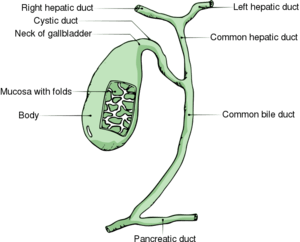Choledocholithiasis
Background
- Occurs when stone expelled from gallbladder becomes impacted in the common bile duct
- If infected, becomes Cholangitis
Anatomy & Pathophysiology

Gallbladder anatomy
- Gallstones are classified as cholesterol stones and pigmented stones (black and brown), and are present in approx 20% of females and 8% of males in the United States
- These stones cause the majority of all biliary tract problems, and depending on where the stone become impacted, specific problems occur.
- Bile flows out the gallbladder, down the cystic duct into the common bile duct, and ultimately into the 1st portion of the duodenum.
Gallbladder disease types
- Acute calculous cholecystitis
- Cholangitis (ascending cholangitis)
- Symptomatic cholelithiasis (biliary colic)
- Acalculous cholecystitis
- Choledocholithiasis
Clinical Features
- RUQ pain
- Radiation to the right shoulder (phrenic nerve irritation)
- Early pain characterized as colicky, intermittent
- Once impacted, is constant and severe
- Nausea and Vomiting
- Jaundice/scleral icterus
- Caused by buildup of direct bilirubin in blood
Differential Diagnosis
RUQ Pain
- Gallbladder disease
- Peptic ulcer disease with or without perforation
- Pancreatitis
- Acute hepatitis
- Pyelonephritis
- Pneumonia
- Kidney stone
- GERD
- Appendicitis (retrocecal)
- Pyogenic liver abscess
- Fitz-Hugh-Curtis Syndrome
- Hepatomegaly due to CHF
- Herpes zoster
- Myocardial ischemia
- Bowel obstruction
- Pulmonary embolism
- Abdominal aortic aneurysm
Evaluation
- LFTs, lipase, and basic chemistry
- Imaging
- RUQ Ultrasound
- Noninvasive and quick
- Common bile duct < 6 mm plus 1mm per decade after 60 yrs old
- US is highly sensitive and specific for acute cholecystitis, much less sensitive/specific in identifying cholelithiasis due to exam limitations (i.e. difficulty identifying the CBD)
- ERCP - highly sensitive and specific, also therapeutic
- MRCP - comparable sensitivity/specificity to ERCP
- HIDA Scan - not useful, as IDA (technetium 99m-labeled iminodiacetic acid) can still go into gallbladder
- RUQ Ultrasound
Management
- Pain control
- Fluid resuscitation and electrolyte repletion
- NPO
- If any concern for concomitant acute cholecystitis, start antibiotics
- Always consider cholangitis
Disposition
- Admission to medical services
- Consult to GI for spherincerotomy and stone removal vs General Surgery for operative management
- Strong predictors for choledocholithiasis on ERCP[1]:
- Clinical ascending cholangitis
- CBD stones on US
- Total bilirubin > 4 mg/dL
See Also
External Links
References
- Magalhaes J et al. Endoscopic retrograde cholangiopancreatography for suspected choledocholithiasis: From guidelines to clinical practice. Feb 2015. World J Gastrointest Endosc. 2015 Feb 16; 7(2): 128–134.
This article is issued from
Wikem.
The text is licensed under Creative
Commons - Attribution - Sharealike.
Additional terms may apply for the media files.